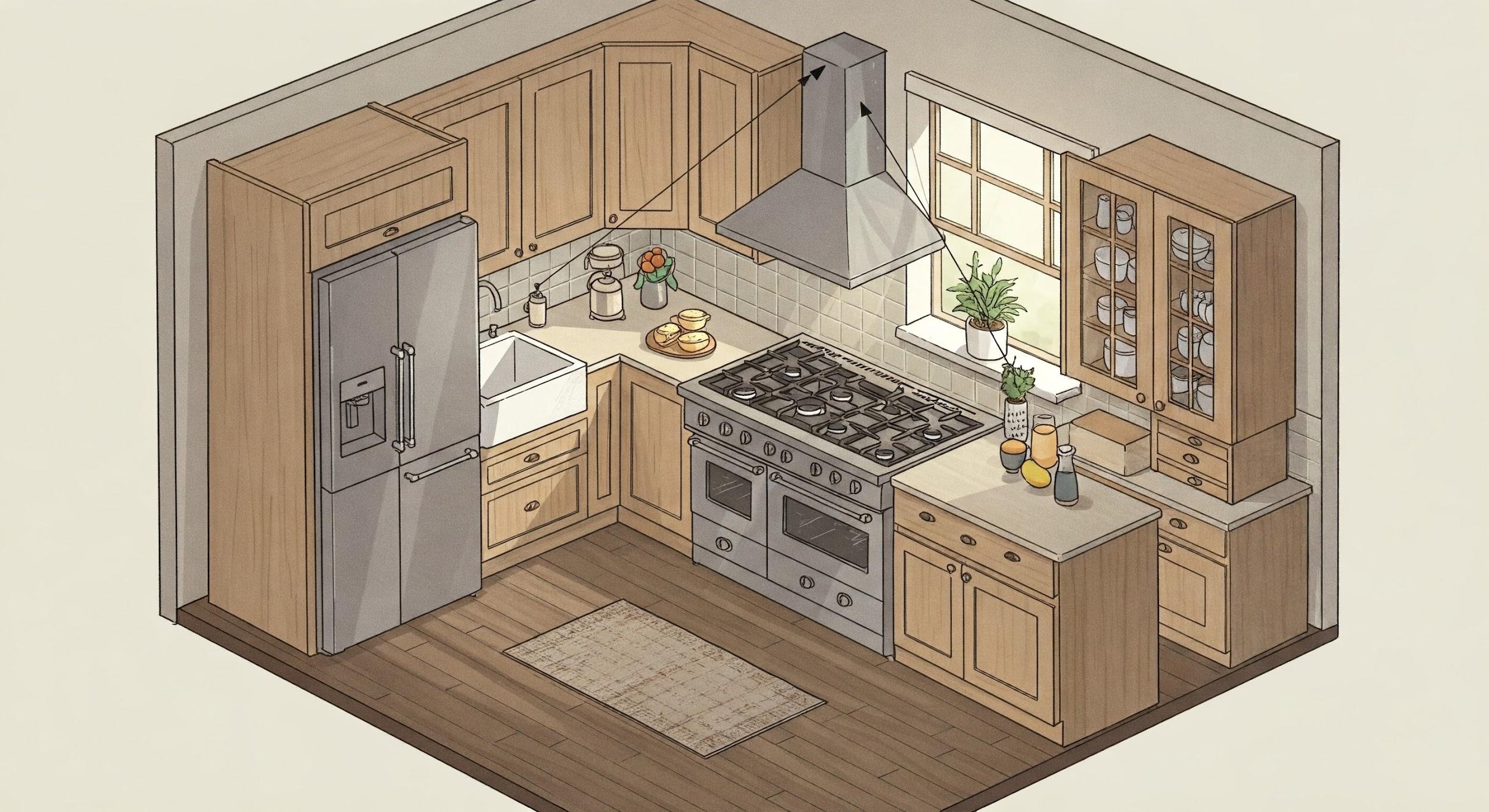
A remodel is an opportunity to improve how your kitchen space is used, but poor planning can lead to frustrating design flaws. An awkward layout, insufficient storage, and poorly placed lighting can make everyday tasks more difficult. Considering workflow, appliance placement, and material durability early in the process helps prevent costly changes later. A well-planned kitchen supports daily routines and avoids common pitfalls that reduce its practicality.
Approximately 40% of homeowners remodel their kitchens because they are dissatisfied with its appearance. While aesthetics are a major factor, design decisions should also improve usability. In this blog, we highlight common kitchen design and remodel mistakes to help homeowners make informed choices that enhance both the look and ease of use of their space.
1. Ignoring the Kitchen Work Triangle

The kitchen work triangle connects the sink, stove, and refrigerator to create a smooth workflow during cooking. Poor placement, such as positioning the refrigerator too far from the sink or placing the stove in a high-traffic area, disrupts this flow.
Maintaining appropriate spacing between these key areas reduces unnecessary movement and prevents congestion. Experts recommend keeping each side of the triangle between 4 and 9 feet to ensure easy access while avoiding overcrowding or wasted steps.
2. Not Enough Counter Space
Adequate counter space is essential for food preparation, appliance storage, and serving. Many kitchen designs fall short by overcrowding counters with appliances or choosing islands that are too small. Experts suggest having at least 36 inches of continuous counter space for prep work and 24 inches of counter space on both sides of the sink to handle daily tasks comfortably.
Including fold-out counters, pull-out cutting boards, or extending countertops along walls helps create additional workspace without altering the layout. Careful planning prevents clutter and ensures sufficient room for cooking, baking, and other activities.
3. Underestimating the Budget and Timeline
Kitchen remodels often exceed initial budgets and timelines when unexpected costs arise. Kurt of Kitchen & More recommends allocating at least 20% of your budget for unforeseen expenses to cover sudden issues like plumbing repairs or material price increases.
Factoring in time for permits, inspections, and supply delays also ensures the project stays on track without last-minute compromises. Overlooking these considerations results in rushed decisions, budget overruns, and incomplete finishes that diminish a kitchen remodel’s overall quality.
4. Poor Lighting Placement
Lighting affects how well a kitchen functions and feels. Relying only on overhead lighting leaves work areas in shadow, making tasks like chopping or cooking more difficult. Combine task lighting under cabinets, ambient lighting for overall illumination, and accent lighting for decorative elements to ensure the entire kitchen is well-lit.
Placing LED strips under cabinets also brightens countertops, while pendant lights over islands add focused lighting for meal prep and dining. Without proper lighting placement, even a well-designed kitchen can feel impractical and incomplete.
5. Oversized or Undersized Kitchen Island
A poorly sized kitchen island disrupts both movement and usability. An island that’s too large can obstruct walkways and create bottlenecks, while one that’s too small fails to provide useful storage or seating. Experts recommend at least 42 inches of clearance around all sides to allow easy navigation and accommodate multiple users.
The island’s size should be proportionate to the kitchen, offering enough surface for serving, storage, or seating without overwhelming the space or limiting movement. Thoughtful sizing ensures the island enhances the kitchen’s layout instead of hindering it.
6. Lack of Proper Ventilation
Without proper ventilation, smoke, odors, and moisture accumulate quickly in a kitchen. Many homeowners overlook this critical element, leading to lingering smells and grease buildup. A vented range hood that ducts to the exterior removes heat and airborne particles effectively. For reliable airflow, the hood’s CFM rating must match the stove’s output to ensure clean air, reduced humidity, and protection for kitchen surfaces during cooking.
A common rule of thumb is to provide at least 1 CFM (cubic foot per minute) of airflow per 100 BTUs (British Thermal Units) of your stove's maximum output. This means that a stove with a total output of 50,000 BTUs would require a range hood with a minimum capacity of 500 CFM to effectively remove smoke, steam, and cooking odors.
7. Insufficient Storage Solutions
A well-organized kitchen largely depends on having smart storage areas. Many designs fail to use vertical space, leaving valuable wall areas unused. Shallow drawers and empty corners further limit storage potential.
For more storage space, consider installing ceiling-height cabinets to increase storage for infrequently used items, and pull-out pantry systems to improve access to everyday essentials. Deep drawers with dividers can also keep cookware in place, and corner units like lazy Susans help prevent dead space.
8. Not Planning for Trash and Recycling Bins
Trash and recycling bins often become an afterthought in kitchen design, leading to cluttered floors and inconvenient placement. Integrating pull-out bins within cabinets keeps waste out of sight without sacrificing accessibility.
Placing bins near food prep areas or sinks simplifies cleanup and ensures that waste disposal remains quick and efficient. Allocating dedicated spaces for both trash and recycling during the design phase prevents last-minute adjustments that compromise convenience and aesthetics.
9. Choosing Trendy Over Timeless Finishes
Trendy finishes can quickly date your kitchen, making it feel outdated within a few years. Bold cabinets, colorful backsplashes, or unusual countertop materials may lose appeal over time, reducing the kitchen’s long-term value.
Opting for neutral palettes and classic materials like quartz countertops, wood cabinetry, or subway tiles provides a timeless look that lasts. Thoughtful material choices allow homeowners to refresh their kitchens with small updates without committing to costly renovations when trends change.
10. Forgetting Electrical Outlets in Key Areas
Poor outlet placement limits appliance use and disrupts daily tasks. A well-planned kitchen includes at least one outlet every 4 feet of counter space, ensuring easy access for coffee makers, blenders, and toasters. Without enough outlets, small appliances end up clustered in one spot, creating tangled cords and cluttered surfaces.
Installing outlets inside drawers can help keep charging devices hidden, while placing them on island sides prevents cords from stretching across work areas.
11. Poorly Placed or Inadequate Seating
Cramped seating at kitchen islands and breakfast bars makes dining and meal prep uncomfortable. Each seat requires 24 inches of space to prevent crowding, and a 15-inch overhang allows knees to rest naturally without hitting cabinetry. Placing stools too close together limits movement, while positioning seating in walkways blocks access to appliances and prep zones.
Proper spacing ensures that stools remain usable without interfering with traffic flow. Skipping these measurements often results in an island that lacks both practicality and everyday usability.
12. Failing to Extend Cabinetry to the Ceiling
Cabinet gaps near the ceiling waste storage space and attract dust. Extending cabinetry upward provides additional storage for seasonal kitchenware and infrequently used items. This design choice also creates a seamless, built-in appearance that enhances the kitchen’s overall look.
Full-height cabinets reduce maintenance by eliminating hard-to-reach spaces that collect dust. When full extension isn’t possible, installing crown molding or decorative trim covers gaps while giving you a more cohesive kitchen design.
13. Misjudging Appliance Placement
Appliances placed too close together disrupt kitchen workflow and limit accessibility. Dishwashers require 21 inches of clearance from nearby cabinets to ensure doors open fully without obstruction. Placing refrigerators next to ovens exposes them to heat, reducing their efficiency and lifespan.
Thoughtful placement allows appliance doors to open freely, maintains proper airflow, and prevents crowding in work zones. Poor spacing forces constant adjustments during cooking and cleaning, making everyday tasks more challenging.
14. Not Planning for Future Needs
A kitchen that meets today’s needs may become impractical as family size, lifestyle, or mobility changes. Designing with the future in mind ensures long-term usability without frequent renovations.
Wide walkways accommodate growing families or mobility aids, while adjustable shelves and pull-out drawers provide easy access for all ages. Choosing layouts that allow for appliance upgrades or additional storage prevents costly modifications later.
15. Installing the Wrong Flooring Material
Choosing unsuitable flooring increases safety hazards and maintenance challenges in a busy kitchen. Glossy tiles become slippery when wet, while untreated wood and porous stone absorb spills and stains easily.
Durable options like textured porcelain tiles, luxury vinyl planks, or sealed hardwood offer slip resistance, easy cleaning, and long-lasting wear. Failing to consider kitchen-specific demands often leads to floors that require constant upkeep or early replacement due to damage and wear.
Get Your Kitchen Remodel Right the First Time
A successful kitchen remodel comes down to thoughtful planning and attention to detail. Overlooking storage, choosing impractical materials, or misjudging space can turn a dream kitchen into a daily frustration. Taking time to plan for workflow, proper measurements, and future needs helps you avoid these common mistakes.
Simple choices, like placing outlets where they’re needed or selecting durable flooring, make a lasting difference. Do your research, consult with professional kitchen remodeling contractors, and plan carefully to create a kitchen that not only looks great but works well for everyday cooking, gatherings, and everything in between.









